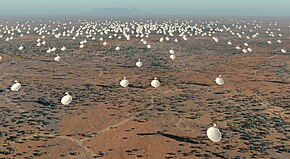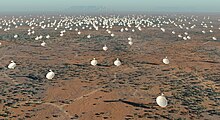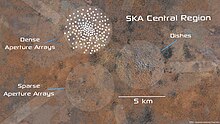Square Kilometre Array: Difference between revisions
→MeerKAT: Remove prediction referring to a date gone past |
ABMvandeBult (talk | contribs) Changed prediction, we can´t be sure this will revolutionize anything. |
||
| Line 29: | Line 29: | ||
The '''Square Kilometre Array''' (SKA) is a [[radio telescope]] in development which will have a total collecting area of approximately one [[square kilometre]].<ref>[http://www.skatelescope.org/ Square Kilometre Array] website.</ref> It will operate over a wide range of frequencies and its size will make it 50 times more sensitive than any other radio instrument. It will require very high performance central computing engines and long-haul links with a capacity greater than the current global [[Internet traffic]].<ref>[http://www.skatelescope.org/PDF/brochure/SKA_Brochure_2010.pdf], ''The Square Kilometre Array'', p.24</ref> It will be able to survey the [[sky]] more than ten thousand times faster than ever before. With receiving stations extending out to distance of 3,000 km from a concentrated central core, it will continue [[radio astronomy]]'s tradition of providing the highest resolution [[image]]s in all [[astronomy]]. The SKA will be built in the [[southern hemisphere]], either in [[South Africa]] or [[Australia]], where the view of our own [[galaxy]], the [[Milky Way]], is best and [[radio interference]] least. With a budget of €1.5 billion, construction of the SKA is scheduled to begin in [[2016]] for initial observations by 2019 and full operation by 2024.{{Citation needed|date=September 2010}} |
The '''Square Kilometre Array''' (SKA) is a [[radio telescope]] in development which will have a total collecting area of approximately one [[square kilometre]].<ref>[http://www.skatelescope.org/ Square Kilometre Array] website.</ref> It will operate over a wide range of frequencies and its size will make it 50 times more sensitive than any other radio instrument. It will require very high performance central computing engines and long-haul links with a capacity greater than the current global [[Internet traffic]].<ref>[http://www.skatelescope.org/PDF/brochure/SKA_Brochure_2010.pdf], ''The Square Kilometre Array'', p.24</ref> It will be able to survey the [[sky]] more than ten thousand times faster than ever before. With receiving stations extending out to distance of 3,000 km from a concentrated central core, it will continue [[radio astronomy]]'s tradition of providing the highest resolution [[image]]s in all [[astronomy]]. The SKA will be built in the [[southern hemisphere]], either in [[South Africa]] or [[Australia]], where the view of our own [[galaxy]], the [[Milky Way]], is best and [[radio interference]] least. With a budget of €1.5 billion, construction of the SKA is scheduled to begin in [[2016]] for initial observations by 2019 and full operation by 2024.{{Citation needed|date=September 2010}} |
||
The SKA is a global collaboration of 20 countries which |
The SKA is a global collaboration of 20 countries which may provide answers to fundamental questions about origin and evolution of the [[Universe]]. {{Citation needed|date=May 2010}} |
||
==Description== |
==Description== |
||
Revision as of 11:47, 1 November 2010
This article needs additional citations for verification. (June 2008) |
This article possibly contains unsourced predictions, speculative material, or accounts of events that might not occur. Information must be verifiable and based on reliable published sources. (April 2010) |
 | |
| Alternative names | SKA |
|---|---|
| Named after | square kilometre, antenna array |
| Location(s) | Australia / South Africa |
| Coordinates | 30°43′16″S 21°24′40″E / 30.72113°S 21.4111278°E |
| Telescope style | Radio telescope |
| Collecting area | 1,000,000 m² |
| Website | skatelescope.org |
| | |

The Square Kilometre Array (SKA) is a radio telescope in development which will have a total collecting area of approximately one square kilometre.[1] It will operate over a wide range of frequencies and its size will make it 50 times more sensitive than any other radio instrument. It will require very high performance central computing engines and long-haul links with a capacity greater than the current global Internet traffic.[2] It will be able to survey the sky more than ten thousand times faster than ever before. With receiving stations extending out to distance of 3,000 km from a concentrated central core, it will continue radio astronomy's tradition of providing the highest resolution images in all astronomy. The SKA will be built in the southern hemisphere, either in South Africa or Australia, where the view of our own galaxy, the Milky Way, is best and radio interference least. With a budget of €1.5 billion, construction of the SKA is scheduled to begin in 2016 for initial observations by 2019 and full operation by 2024.[citation needed]
The SKA is a global collaboration of 20 countries which may provide answers to fundamental questions about origin and evolution of the Universe. [citation needed]
Description
The SKA will combine the signals received from thousands of small antennae spread over a distance of more than 3000 km to simulate a giant radio telescope capable of extremely high sensitivity and angular resolution. The SKA will also have a very large field-of-view (FOV) with a goal at frequencies below 1 GHz of 200 square degrees and of more than 1 square degree (about 5 full Moons) at higher frequencies. One innovative development is the use of phased-array technology to provide multiple FOVs. This will greatly increase the survey speed of the SKA and enable multiple users to observe different pieces of the sky simultaneously. The combination of a very large FOV with high sensitivity means that the SKA will transform the exploration of the Universe.
The SKA will provide continuous frequency coverage from 70 MHz to 10 GHz in the first two phases of its construction. A third phase will then extend the frequency range up to 30 GHz.
Phase 1: Providing ~20% of the total collecting area at low and mid frequencies by 2019.
Phase 2: Completion of the full array at low and mid frequencies by 2024.
Phase 3: Building of the high frequency array from 2022.
The frequency range from 70 MHz to 10 GHz, spanning more than two decades, cannot be realized using one design of antenna and so the SKA will comprise arrays of three types of antenna elements that will make up the SKA-low, SKA-mid and dish arrays:



- SKA-low array - A phased array of simple dipole antennas to cover the frequency range from 70 - 200 MHz. These will be grouped in 100m diameter stations each containing about 90 elements.
- SKA-mid array - This is likely to be a phased array of "tiles" to cover the medium frequency range from 200 to 500 MHz. The 3 metre x 3 metre tiles will be grouped into circular stations, 60 m in diameter.
- Dish Array - several thousand dish antennas to cover the frequency range 500 MHz to 10 GHz. It is expected that the antenna design will follow that of the Allen Telescope Array using an offset Gregorian design having a height of 15 metres and a width of 12 metres. It is hoped that the parabolic dishes will be equipped with focal plane arrays at their focus. This would allow the dishes to observe over a far wider field of view than that achieved with a single element feed. Prototypes of such multiple element feeds are now under development for the pathfinder arrays described below.

The area covered by the SKA - extending out to ~3000 km - will comprise three regions:
- A central region containing 5 km diameter cores of dish antennas, SKA-mid stations and SKA-low antennas. This central region will contain approximately half of the total collecting area of the three SKA arrays.
- A mid region extending out to 180 km. This will contain dishes and pairs of SKA-mid and SKA-low stations. In each case they will be randomly placed within the area with the density of dishes and stations falling off towards the outer part of the region.
- An outer region from 180 km to 3000 km. This will comprise five spiral arms along which dishes, grouped into stations of 20 dishes, will be located. The separation of the stations increases towards the outer ends of the spiral arms.
SKA science
The SKA will be a highly flexible instrument designed to address a wide range of questions in astrophysics, fundamental physics, cosmology and particle astrophysics. It will be able to probe previously unexplored parts of the distant Universe. A number of key science projects have been selected:
Extreme tests of general relativity
For almost ninety years, Einstein’s theory of general relativity has precisely predicted the outcome of every experiment made to test it. Most of these tests, including the most stringent ones, have been carried out using radio astronomical measurements. By using pulsars as cosmic gravitational wave detectors, or timing pulsars found orbiting black holes, astronomers will be able to examine the limits of general relativity such as the behaviour of space and time in regions of extremely curved space. It will then be revealed whether Einstein was correct in his description of space, time and gravity, or if new physics is needed.
Galaxies, cosmology, dark matter and dark energy
The sensitivity of the SKA in the 21-cm hydrogen line will map a billion galaxies out to the edge of the Universe. The large-scale structure revealed will determine the processes by which galaxies formed and grew. Imaging hydrogen through the Universe will provide a three-dimensional picture of the first ripples of structure which will then form individual galaxies and clusters. This will probe the effects of the mysterious “dark energy” that is pushing the Universe apart.
Probing the dark ages — the first black holes and stars
The SKA will be able to fill in the gap — the so called dark ages — between 300,000 years after the Big Bang when the Universe became transparent, and a billion years later when young galaxies are seen. By observing the primordial distribution of gas, the SKA will see how the Universe gradually lit up as its stars and galaxies formed and then evolved.
The origin and evolution of cosmic magnetism
It is still not possible to answer basic questions about the origin and evolution of cosmic magnetic fields, but it is clear that they are an important component of interstellar and intergalactic space. By mapping the effects of magnetism on the radiation from very distant galaxies, the SKA will reveal the form of cosmic magnetism and the role it has played in the evolving Universe.
The cradle of life
The SKA will be able to detect extremely weak extraterrestrial signals, and may even spot other planets capable of supporting life. Astrobiologists will use the SKA to search for amino acids, the building blocks of life, by identifying spectral lines at specific frequencies.
Locations

Suitable sites for the SKA need to be in unpopulated areas with guaranteed very low levels of man-made radio interference. Four sites were initially proposed in South Africa, Australia, Argentina and China[3]. After considerable site evaluation surveys, Argentina and China were dropped and two sites are now shortlisted:
Australia: The core site is located at Boolardy 26°59′S 116°32′E / 26.983°S 116.533°E in Western Australia 315 km north-east of Geraldton[4] on a flat desert-like plain at an elevation of about 460 metres. The most distant stations will be located in New Zealand.[5] [6]
South Africa: The core site is located at 30°43′16.068″S 21°24′40.068″E / 30.72113000°S 21.41113000°E at an elevation of about 1000 metres in the Karoo area of the arid Northern Cape Province, about 75 km north-west of Carnarvon, with distant stations in Ghana, Kenya, Madagascar, and Mauritius.
The final decision on the site will be made in 2011 or 2012.
Precursors, Pathfinders and Design Studies
Many groups are working globally to develop the technology and techniques required for the SKA. Their contributions to the international SKA project are classified as either: Precursors, Pathfinders or Design Studies.
- Precursor facility: A telescope on one of the two SKA candidate sites, carrying out SKA-related activity.
- Pathfinder: A telescope or programme carrying out SKA-related technology, science and operations activity.
- Design Study: A study of one or more major sub-systems of the SKA design, including the construction of prototypes
Precursor facilities
Australian SKA Pathfinder (ASKAP)
The Australian SKA Pathfinder, or ASKAP, is a AU$100 million project to build an array of 36, 12m dishes employing advanced phased array feeds to give a wide field of view (30 square degrees). ASKAP will be built on the Australian Boolardy site. Completion of the array which covers the frequency range 700 to 1,700 MHz is scheduled for 2012[7].
MeerKAT
MeerKAT is a 860 million Rand project to build an array of 50 or more 12m diameter dishes to enable technology required for the SKA to be developed. KAT-7, a seven-dish engineering testbed and science instrument near Carnarvon in the Northern Cape Province of South Africa, the full array is expected to be ready to do science by 2012. The dishes will be equipped with wide band single feeds to cover frequencies from 800 MHz up to 8 GHz[8].
Murchison Widefield Array (MWA)
Pathfinders
APERture Tile In Focus (APERTIF)
Arecibo Observatory
Allen Telescope Array
The Allen Telescope Array (ATA) uses innovative 6.1m offset Gregorian dishes equipped with wide band single feeds covering frequencies from 500 MHz to 11 GHz. The 42-element array now in operation is to be extended to 350 elements. The dish design has explored methods of low-cost manufacture. [4]
electronic European VLBI Network (eVLBI)
Electronic MultiBeam Radio Astronomy ConcEpt (EMBRACE)
e-MERLIN
Expanded Very Large Array (EVLA)
LOFAR
LOFAR is a €120 million Dutch project building a novel low frequency phased aperture arrays spread over northern Europe. An all-electronic telescope covering low frequencies from 40 to 240 MHz completion is scheduled for 2009. LOFAR will demonstrate crucial processing techniques vital to the SKA[9].
Long Wavelength Array (LWA)
SKA Molonglo Prototype (SKAMP)
Design Studies
Aperture Array Verification Programme (AAVP)
Canadian SKA Program
Preparatory Study for the SKA (PrepSKA)
US Technology Development Programme (TDP)
The Technology Development Programme, or TDP, is a $12 million US programme to specifically develop dish and feed technology for the SKA. It is operated by a consortium of universities led by Cornell University and completes in 2012. [13]
Timeline and funding
The SKA was originally conceived in the early 1990s with an international working group set up in 1994. This led to the signing of the first Memorandum of Agreement in 2000. Considerable early development work then followed. This culminated in the commencement of PrepSKA in 2008 leading to a full SKA design in 2012. Construction of Phase 1 will take place from 2016 to 2019 providing an operational array capable of carrying out the first science. Phase 2 will then follow for completion in 2024 providing full sensitivity for frequencies up to 10 GHz.
The SKA is projected to cost €1.5bn for phases 1 and 2 completing in 2024, this includes €300m for Phase 1 completing 2019. The funding will come from many international funding agencies. Preliminary expectations are that Europe, the United States and the rest of the world will each contribute a third of the project's funding. The SKA and the European Extremely Large Telescope, E-ELT, are the two flagship facilities for ground-based astronomy in the future and are equal high priority projects in the ASTRONET roadmap for European astronomy.
See also
- List of radio telescopes
- LOFAR (the Low Frequency Array, currently under construction in the Netherlands)
- Mills Cross (historical connections with the SKA development in Australia)
- Project Cyclops
- Photographs from the Boolardy site, June 2010
References
- ^ Square Kilometre Array website.
- ^ [1], The Square Kilometre Array, p.24
- ^ Koenig, Robert (18 August 2006). "RADIO ASTRONOMY: Candidate Sites for World's Largest Telescope Face First Big Hurdle". Science. 313 (5789). AAAS: 910–912. doi:10.1126/science.313.5789.910.
{{cite journal}}:|access-date=requires|url=(help) - ^ "Aiming for the skies". The Age. 7 April 2008.
- ^ Amos, J. Nations vie for giant telescope, BBC News, 28 September 2006.
- ^ Science Network WA, 16 February 2007
- ^ ASKAP website
- ^ South African SKA website.
- ^ LOFAR website
External links
- Australia
- "Australia may host Square Kilometre Array", Cosmos magazine, September 2006
- "Australian SKA Planning Office Newsletter" (PDF). CSIRO. 10, April 2007. Retrieved 2007-03-19.
{{cite web}}: Check date values in:|date=(help) - SKA Australia web site
- Boolardy Station and the Murchison Radio-Astronomy Observatory (MRO) - University of Western Australia
- Canada
- Europe
- South Africa

